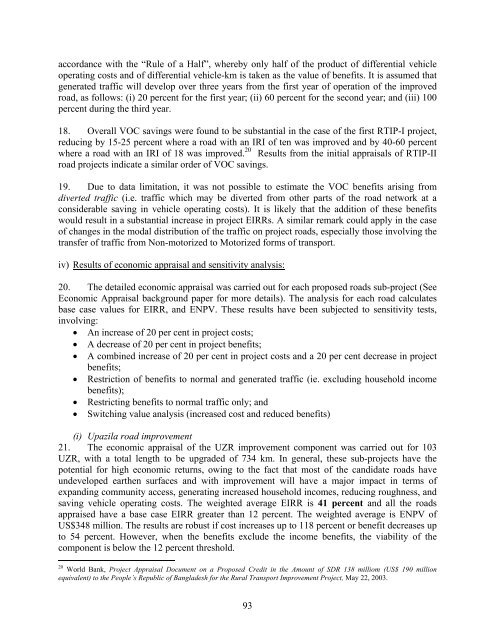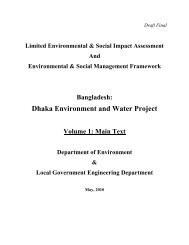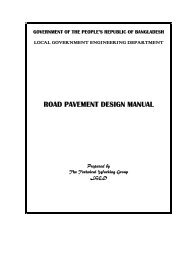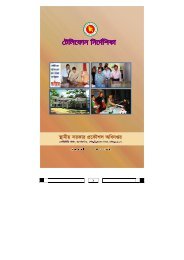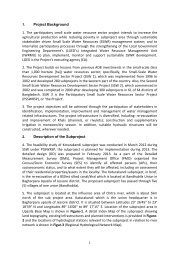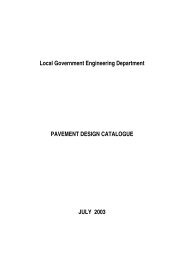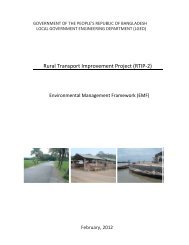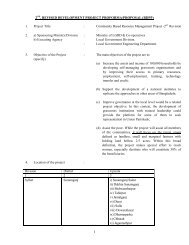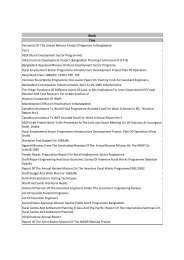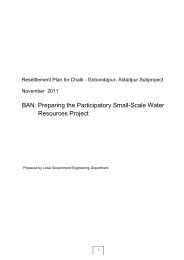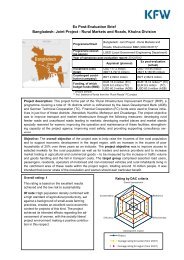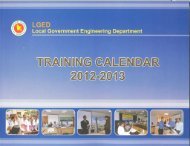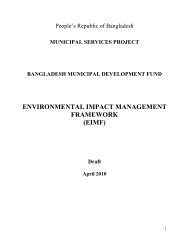PAD - LGED
PAD - LGED
PAD - LGED
Create successful ePaper yourself
Turn your PDF publications into a flip-book with our unique Google optimized e-Paper software.
accordance with the “Rule of a Half”, whereby only half of the product of differential vehicle<br />
operating costs and of differential vehicle-km is taken as the value of benefits. It is assumed that<br />
generated traffic will develop over three years from the first year of operation of the improved<br />
road, as follows: (i) 20 percent for the first year; (ii) 60 percent for the second year; and (iii) 100<br />
percent during the third year.<br />
18. Overall VOC savings were found to be substantial in the case of the first RTIP-I project,<br />
reducing by 15-25 percent where a road with an IRI of ten was improved and by 40-60 percent<br />
where a road with an IRI of 18 was improved. 20 Results from the initial appraisals of RTIP-II<br />
road projects indicate a similar order of VOC savings.<br />
19. Due to data limitation, it was not possible to estimate the VOC benefits arising from<br />
diverted traffic (i.e. traffic which may be diverted from other parts of the road network at a<br />
considerable saving in vehicle operating costs). It is likely that the addition of these benefits<br />
would result in a substantial increase in project EIRRs. A similar remark could apply in the case<br />
of changes in the modal distribution of the traffic on project roads, especially those involving the<br />
transfer of traffic from Non-motorized to Motorized forms of transport.<br />
iv) Results of economic appraisal and sensitivity analysis:<br />
20. The detailed economic appraisal was carried out for each proposed roads sub-project (See<br />
Economic Appraisal background paper for more details). The analysis for each road calculates<br />
base case values for EIRR, and ENPV. These results have been subjected to sensitivity tests,<br />
involving:<br />
• An increase of 20 per cent in project costs;<br />
• A decrease of 20 per cent in project benefits;<br />
• A combined increase of 20 per cent in project costs and a 20 per cent decrease in project<br />
benefits;<br />
• Restriction of benefits to normal and generated traffic (ie. excluding household income<br />
benefits);<br />
• Restricting benefits to normal traffic only; and<br />
• Switching value analysis (increased cost and reduced benefits)<br />
(i) Upazila road improvement<br />
21. The economic appraisal of the UZR improvement component was carried out for 103<br />
UZR, with a total length to be upgraded of 734 km. In general, these sub-projects have the<br />
potential for high economic returns, owing to the fact that most of the candidate roads have<br />
undeveloped earthen surfaces and with improvement will have a major impact in terms of<br />
expanding community access, generating increased household incomes, reducing roughness, and<br />
saving vehicle operating costs. The weighted average EIRR is 41 percent and all the roads<br />
appraised have a base case EIRR greater than 12 percent. The weighted average is ENPV of<br />
US$348 million. The results are robust if cost increases up to 118 percent or benefit decreases up<br />
to 54 percent. However, when the benefits exclude the income benefits, the viability of the<br />
component is below the 12 percent threshold.<br />
20 World Bank, Project Appraisal Document on a Proposed Credit in the Amount of SDR 138 milliom (US$ 190 million<br />
equivalent) to the People’s Republic of Bangladesh for the Rural Transport Improvement Project, May 22, 2003.<br />
93


